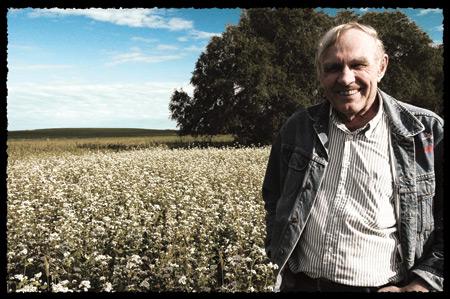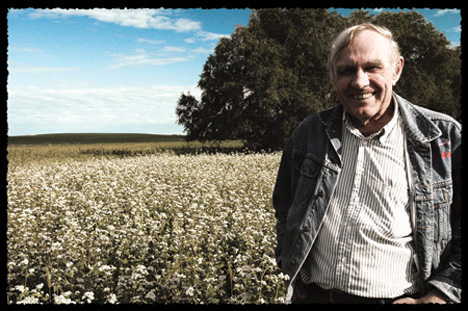An April 13, the Natural Resources Defense Council (NRDC) announced the four winners of its second annual “Growing Green” awards, which honor leaders in the sustainable-food world. The four categories are “thought leader,” “producer,” business leader,” and “water steward.” Over the next few days, I’ll be interviewing the winners in each category. First up: Fred Kirschenmann, who took “thought leader” honors.
——-
 Fred Kirschenmann: an original agri-intellectual gets his due. Fred Kirschenmann is a long-time organic farmer with a doctorate in philosophy from the University of Chicago. He holds positions at Iowa State University’s Leopold Center for Sustainable Agriculture University and at the New York-based Stone Barns Center for Food and Agriculture. Fred proudly embodies the title of “agri-intellectual,” a term derisively coined by conventional farmer Blake Hurst in the right-wing magazine The American.
Fred Kirschenmann: an original agri-intellectual gets his due. Fred Kirschenmann is a long-time organic farmer with a doctorate in philosophy from the University of Chicago. He holds positions at Iowa State University’s Leopold Center for Sustainable Agriculture University and at the New York-based Stone Barns Center for Food and Agriculture. Fred proudly embodies the title of “agri-intellectual,” a term derisively coined by conventional farmer Blake Hurst in the right-wing magazine The American.
Industrial agriculturalists may sneer at Fred, but for me and for the broader sustainable food movement, he has been a kind of intellectual mentor. He is superb at providing a bird’s eye view of the food system — looking at the great flows of energy, capital, and goods that align to put food on our plates. No one who has listened to one of his hundreds of talks over the past several years can walk away without understanding that the current system is hopelessly reliant on cheap and abundant fossil fuel energy. If that uncomfortable fact has become common knowledge within the movement and even outside of it, we have Fred to thank.
Perhaps more importantly, Fred is expert at identifying the ecological niches and synergies that create smarter, less wasteful, yet quite-abundant systems. You leave Fred’s talks awed at the vastness of the task ahead of us — yet hopeful in the knowledge that change is afoot. Fred comes by his big-picture view of the world honestly, growing up on a farm in the plains of North Dakota. In the 1980s, he established himself as a agricultural pioneer by taking the Kirschenmann Family Farm — all 3500 acres of it — organic. Just after the announcement of his “Growing Green” prize, I reached Fred via phone at his office at Stone Barns.
Q. What ideas floating around the agriculture world are you most excited about?
A. For one, the Land Institute and their research in perennializing grain crops is terribly important because we’ve got to do a better job of maintaining the biological health of our soil and perennials would do a much better job of that. The Land Institute, in doing its research over the last thirty years, has developed some varieties now that are looking good. In fact, they’re making some flour from perennial wheat varieties that they’ve developed.
The Land Institute has proposed a fifty-year farm bill to the USDA, to really move this forward, which I think is a very creative idea. I don’t know whether they [the USDA] will pick up on it or not. But that’s one idea that’s out there that I think is going to become so important, particularly as energy costs go up, etc.
Another exciting idea is what individual farmers are doing all around the world now: converting from high input/output systems of agriculture, the basic industrial model, to models that are based on what I call biological synergies, that is where they have a diversity of plants and animals in which the waste from one species becomes the food for another. And they’re producing much more food because it’s not a monoculture, so there are more food products coming off per acre, and doing it at vastly reduced energy costs.
Q. Given all the trends in ag happening now–the emerging ecological models you’re talking about, the continuing dominance of industrial food–where do you see U.S. agriculture in twenty years?
A. Well, there are two major movements. There’s this movement in a new direction: recognizing that we need to now shift from an industrial agricultural model to an ecological agricultural model. And that’s gaining some traction, [though] it’s still a small part of our agricultural system. And then on the other side there’s the effort to buck up the industrial model with new technology. And of course the ecological model is now becoming just popular enough that it’s starting to serve as a threat to the old model. This is typical of any change–it’s the way change has always happened historically: you have those who resist the change and want to keep the current system going, and those who recognize we need to change and side with the change.
There are farmers and processors and other people in the food who have made huge investments in the industrial model. So they’re going to understandably–and we should expect–that they will continue to try to defend that model as long as they possibly can. And I think we should be appreciative of that and reach out and try to work with them.
But in the long run, given the fact that our industrial model is so dependent on cheap energy, when you look ahead 10, twenty years, it’s just not going to be viable, in any way I can see. So I think that in twenty years, what we’re going to see is an agriculture that is much more diverse, because you’re going to need those biological synergies as a way of making those systems work. I think the farms are going to be somewhat smaller because when you operate farms on an ecological basis, you need more intimate knowledge about your local ecology if you’re going to manage it well. And I think that a food system is going to be more regionalized. I have to say I’m not a big advocate on the local food concept because it sort of limits you to a radius of, say, like 150 miles.
When you think about it as a total food system, because NYC has some 30 million people. You’re going to feed them all from 150 miles around NYC? Probably not. North Dakota only has 630,000 people in the whole state. If they all ate from 150 miles, 90 percent of the farmland would probably lay idle. So, we have to think about this. I think we’ll evolve to a regional concept in which people become more engaged in their own food systems in their own regions–systems that are appropriate to their own place.
Q. What can citizens do to help bring about this transition to a more ecological farming style?
A. I’m glad you use the word citizen. I like to use the phrase “food citizen” because right now, we’ve all come out of this 200 year culture of industrialization and so we tend to think of ourselves in special categories: so we’re either farmers and producers, or we’re consumers. But increasingly now, as people want to know where their food comes from, they’re becoming more engaged and involved.
So we’re starting to see now farmers and consumers sitting down together as food citizens and thinking about what’s the food system that works for them. And CSAs and farmers markets are the beginnings, the starting point, of that kind of model.
I think that what ordinary food citizens in their own communities can do is a couple of things: one, when they go to buy food in their supermarket, and they’re not sure about where the food comes from or whether it is what they want, they should ask to talk to the manager of that food section and ask the questions that they have. One of the things that people don’t often realize [is] that in the food business, the ordinary customer has a lot of power because people who are in the food business understand perfectly well, that when they lose a customer, they can’t replace the loss of that customer by getting their existing customers to eat more.
Now, if you’re manufacturing computers, and you lose a customer, you can always get your existing customers to upgrade more often or whatever. You don’t have that flexibility in food. So, studies have been done which indicate when 15 people go into the same supermarket, in the same week and ask for the same product, they will almost invariably get that product on the shelf.
So they can do that, and they can also begin to think about producing some of their own food, turning part of their lawns into a garden, like Michelle Obama did. Whatever it takes-become more acquainted, take more charge, more control. Almost everyone could do that. Even if we live in an apartment in NYC, there’s probably some place where you could put a raised bed and grow some food.




